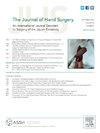绘制内上髁肌腱起源图以改善内上髁炎的治疗:解剖学研究。
IF 2.1
2区 医学
Q2 ORTHOPEDICS
引用次数: 0
摘要
目的:内上髁炎是一种常见于投掷和高尔夫运动员的肌腱病。虽然可以选择非手术疗法,但如果这些疗法无效,就需要考虑手术治疗。进行手术治疗时,目的是将病变组织从上髁剥离。本研究的目的是明确屈肌腱总腱和内侧副韧带(MCL)相对于内侧髁后脊的位置和大小:方法:解剖六只尸体肘部的屈肌腱总腱和内侧副韧带,并反映其在内侧髁上的起源。从内上髁的后脊和远脊测量肱骨。同时还测量了每个起源的高度和宽度:结果:尺骨屈肌起点距离内上髁后脊平均为 4.2 毫米,向前方延伸平均为 4.8 毫米。桡侧屈肌起始于距后脊平均 4.2 毫米处,向前方平均延伸 7.4 毫米。旋前肌从距后脊平均 4.6 毫米处开始,向前方平均延伸 5.7 毫米。MCL 从后嵴平均 10.4 毫米处开始,向前方平均延伸 5.2 毫米:结论:通过测量,可以绘制出内上髁上屈肌腱的具体起源及其大小,以及它们与 MCL 的相对位置图:外科医生可从内上髁后脊向前方剥离 1 厘米,以安全地处理受影响的组织,并确保 MCL 的安全性和完整性。本文章由计算机程序翻译,如有差异,请以英文原文为准。
Mapping Origins of Tendons on the Medial Epicondyle to Improve Treatment of Medial Epicondylitis: Anatomical Study
Purpose
Medial epicondylitis is a tendinosis found commonly in throwing and golfing athletes. Although there are choices for nonsurgical treatments, when these fail, surgical intervention can be considered. When surgical treatment is performed, the objective is to debride the diseased tissue from the epicondyle. The purpose of this study was to clarify the locations and size of the common flexor tendons and medial collateral ligament (MCL) relative to each other and to the posterior ridge of the medial epicondyle.
Methods
The common flexor tendons and MCL were dissected and reflected their origin on the medial epicondyle in six cadaver elbows. Measurements were taken from the posterior and distal ridges of the medial epicondyle with respect to the humerus. Each origin was also measured for its height and width.
Results
The flexor carpi ulnaris origin starts at a mean of 4.2 mm from the posterior ridge of the medial epicondyle and extends anteriorly an average of 4.8 mm. The flexor carpi radialis starts at a mean of 4.2 mm from the posterior ridge and extends anteriorly an average of 7.4 mm. The pronator teres begins at a mean of 4.6 mm from the posterior ridge and extends an average of 5.7 mm anteriorly. The MCL starts at an average of 10.4 mm from the posterior ridge and extends 5.2 mm anteriorly.
Conclusions
The measurements found have allowed the creation of a map of the specific common flexor tendon origins and their sizes on the medial epicondyle, as well as their position relative to the MCL.
Clinical relevance
A surgeon may debride 1 cm anteriorly from the posterior ridge of the medial epicondyle to safely address the affected tissues and ensure the safety and integrity of the MCL.
求助全文
通过发布文献求助,成功后即可免费获取论文全文。
去求助
来源期刊
CiteScore
3.20
自引率
10.50%
发文量
402
审稿时长
12 weeks
期刊介绍:
The Journal of Hand Surgery publishes original, peer-reviewed articles related to the pathophysiology, diagnosis, and treatment of diseases and conditions of the upper extremity; these include both clinical and basic science studies, along with case reports. Special features include Review Articles (including Current Concepts and The Hand Surgery Landscape), Reviews of Books and Media, and Letters to the Editor.

 求助内容:
求助内容: 应助结果提醒方式:
应助结果提醒方式:


